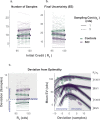Hyperreactivity to uncertainty is a key feature of subjective cognitive impairment
- PMID: 35536752
- PMCID: PMC9197396
- DOI: 10.7554/eLife.75834
Hyperreactivity to uncertainty is a key feature of subjective cognitive impairment
Abstract
With an increasingly ageing global population, more people are presenting with concerns about their cognitive function, but not all have an underlying neurodegenerative diagnosis. Subjective cognitive impairment (SCI) is a common condition describing self-reported deficits in cognition without objective evidence of cognitive impairment. Many individuals with SCI suffer from depression and anxiety, which have been hypothesised to account for their cognitive complaints. Despite this association between SCI and affective features, the cognitive and brain mechanisms underlying SCI are poorly understood. Here, we show that people with SCI are hyperreactive to uncertainty and that this might be a key mechanism accounting for their affective burden. Twenty-seven individuals with SCI performed an information sampling task, where they could actively gather information prior to decisions. Across different conditions, SCI participants sampled faster and obtained more information than matched controls to resolve uncertainty. Remarkably, despite their 'urgent' sampling behaviour, SCI participants were able to maintain their efficiency. Hyperreactivity to uncertainty indexed by this sampling behaviour correlated with the severity of affective burden including depression and anxiety. Analysis of MRI resting functional connectivity revealed that SCI participants had stronger insular-hippocampal connectivity compared to controls, which also correlated with faster sampling. These results suggest that altered uncertainty processing is a key mechanism underlying the psycho-cognitive manifestations in SCI and implicate a specific brain network target for future treatment.
Keywords: affective disorders; decision making; hippocampus; human; information gathering; insula; neuroscience; uncertainty.
© 2022, Attaallah et al.
Conflict of interest statement
BA, PP, ES, VT, YS, SM, MH No competing interests declared
Figures











Similar articles
-
Subjective Cognitive Impairment in 55-65-Year-Old Adults Is Associated with Negative Affective Symptoms, Neuroticism, and Poor Quality of Life.J Alzheimers Dis. 2019;67(4):1367-1378. doi: 10.3233/JAD-180810. J Alzheimers Dis. 2019. PMID: 30689577 Free PMC article.
-
Resting-state synchrony between the retrosplenial cortex and anterior medial cortical structures relates to memory complaints in subjective cognitive impairment.Neurobiol Aging. 2015 Jun;36(6):2145-52. doi: 10.1016/j.neurobiolaging.2015.03.006. Epub 2015 Mar 14. Neurobiol Aging. 2015. PMID: 25862421
-
Self-report instruments of cognitive failures as screening tools for Subjective Cognitive Impairment in older adults.Hell J Nucl Med. 2017 Sep-Dec;20 Suppl:58-70. Hell J Nucl Med. 2017. PMID: 29324915
-
The pre-mild cognitive impairment, subjective cognitive impairment stage of Alzheimer's disease.Alzheimers Dement. 2008 Jan;4(1 Suppl 1):S98-S108. doi: 10.1016/j.jalz.2007.11.017. Alzheimers Dement. 2008. PMID: 18632010 Review.
-
Subjective cognitive impairment.Curr Opin Psychiatry. 2012 Nov;25(6):445-50. doi: 10.1097/YCO.0b013e3283586fd8. Curr Opin Psychiatry. 2012. PMID: 23037961 Review.
Cited by
-
Negative affective burden is associated with higher resting-state functional connectivity in subjective cognitive decline.Sci Rep. 2022 Apr 13;12(1):6212. doi: 10.1038/s41598-022-10179-y. Sci Rep. 2022. PMID: 35418579 Free PMC article.
-
The role of the human hippocampus in decision-making under uncertainty.Nat Hum Behav. 2024 Jul;8(7):1366-1382. doi: 10.1038/s41562-024-01855-2. Epub 2024 Apr 29. Nat Hum Behav. 2024. PMID: 38684870 Free PMC article.
-
Multidimensional assessment of time perception along the continuum of Alzheimer's Disease and evidence of alterations in subjective cognitive decline.Sci Rep. 2023 Dec 13;13(1):22117. doi: 10.1038/s41598-023-49222-x. Sci Rep. 2023. PMID: 38092802 Free PMC article.
-
Apathy and effort-based decision-making in Alzheimer's disease and subjective cognitive impairment.Alzheimers Dement (Amst). 2024 Oct 16;16(4):e70013. doi: 10.1002/dad2.70013. eCollection 2024 Oct-Dec. Alzheimers Dement (Amst). 2024. PMID: 39416486 Free PMC article.
-
Cognitive trajectories in longitudinally trained 3xTg-AD mice.Physiol Behav. 2024 Mar 1;275:114435. doi: 10.1016/j.physbeh.2023.114435. Epub 2023 Dec 14. Physiol Behav. 2024. PMID: 38103626 Free PMC article.
References
-
- Abramson LY, Seligman ME, Teasdale JD. Learned helplessness in humans: critique and reformulation. Journal of Abnormal Psychology. 1978;87:49–74. - PubMed
-
- Acerbi L, Ma WJ. Practical Bayesian optimization for model fitting with Bayesian adaptive direct search. Advances in Neural Information Processing System; 2017. pp. 1837–1847.
-
- Acosta E. Subjective and Objective Determinants of Expectancy: Similarities and Differences. The American Journal of Psychology. 1982;95:139. doi: 10.2307/1422664. - DOI
Publication types
MeSH terms
Grants and funding
LinkOut - more resources
Full Text Sources
Other Literature Sources

